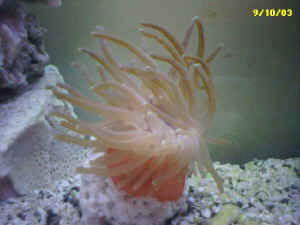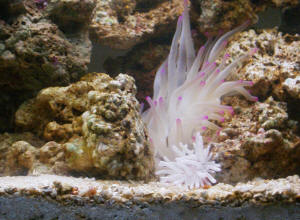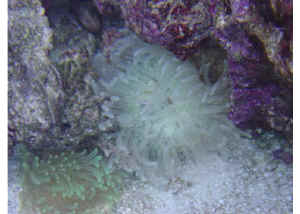|
FAQs on Condylactis Anemone
Identification
Related Articles: Condylactis Anemones, Anemones,
Anemones of
the Tropical West Atlantic, Colored/Dyed Anemones,
Related FAQs: Anemone ID 1, Anemone ID 2, Anemone ID 3, Anemone ID
4, Anemone
ID 5, Anemone ID
6,
Anemone ID 7,
Anemone ID 8,
Anemone ID 9, Anemone ID 10,
Anemone ID
11,
Anemone ID 12, Anemone ID 13, Anemone ID 14, Anemone ID 15,
Anemone ID
16, Anemone ID 17, Anemone ID 18, Anemone ID 19,
Anemone ID 20,
Anemone ID 21, Anemone ID 22, Anemone ID 23, Anemone ID 24, Anemone ID 25, Anemone ID 26, Anemone ID 27, Anemone ID 28, Anemone ID 29, Anemone
ID 30, Anemone ID 31,
Anemone ID 32,
Anemone ID 33,
Anemone ID 34, Anemone ID 35,
Anemone ID 36, Anemone ID 37, Anemone ID 38, Anemone ID 39, Anemone ID 40,
Anemone ID 42,
Anemone ID 43, Anemone ID 44,
Anemone ID 45,
&
Cnidarian
Identification,
Related FAQs: Condylactis
1, Condylactis 2,
Anemone
Identification, Condylactis
Compatibility, Condylactis
Behavior, Condylactis
Selection, Condylactis Systems,
Condylactis Feeding, Condylactis Disease, Condylactis Reproduction,
Atlantic
Anemones 1, Atlantic Anemones 2,
Anemones, Anemones 2,
LTAs, Clownfishes & Anemones, Anemone Systems, Anemone
Lighting, Anemone
Reproduction, Anemone Compatibility, Anemone
Selection, Anemone Behavior,
Anemone
Health, Anemone
Placement, Anemone
Feeding,
|

|
 |
New Print and
eBook on Amazon:
Anemone Success
Doing what it takes to keep Anemones healthy long-term
by Robert (Bob) Fenner
|
Taxonomic info 12/11/12
Hi WWM crew,
I came across this page, http://65.36.157.188/condyanemones.htm, and
thought to send a few taxonomic corrections to you:
Condylactis passiflora is an unaccepted name; the accepted name
is Condylactis gigantea
(http://www.marinespecies.org/aphia.php?p=taxdetails&id=458658).
Mithrax cinctimanus was moved into the genus, Mithraculus
by H. P. Wagner, 1990, Zool. Verh. (Leiden) 264:48-53. Accepted name:
Mithraculus cinctimanus.
Although not on that web page, the Pederson's cleaner shrimp,
also a symbiont found with C. gigantea and Bartholomea annulata (ringed
or corkscrew anemone) has moved from the genus Periclimenes to
the genus Ancylomenes by Okuno and Bruce (2010) Designation of
Ancylomenes gen. nov., for 'Periclimenes aesopius species group'
(Crustacea: Decapoda: Palaemonidae), with the description of a new
species and a checklist of congeneric species. Zootaxa 2372: 85-105.
Accepted name: Ancylomenes pedersoni.
Sincerely,
Nancy Sheridan
Florida Fish and Wildlife Conservation Commission
Fish and Wildlife Research Institute
100 8th Ave SE
St. Petersburg, FL 33701
http://myfwc.com/research/
<Thank you for these updates. As principally a hobbyist site, we do tend
to "lag" (e.g. not recognizing the addition, movement of genera, species
in Veron's recent Scleractinia works), be more of lumpers than splitters
taxonomically... but it is important to provide current systematics.
Will post your input here re these species. Bob Fenner>
Re: Taxonomic info, Condylactis conservation
12/11/12
Thanks for the reply and you're welcome for the info. Also, in case you
haven't heard, a three-year prohibition on the recreational and
commercial harvest of Condys in Florida state and federal waters went
into effect Nov. 1, 2012. For more info, please see -
http://myfwc.com/news/news-releases/2012/october/24/marine-life/.
Nancy
<Ah, I thank you for this note as well. Have a long-standing disregard
for the use of Actinarians in the ornamental trade... not worth their
extraction in my view. Cheers, Bob Fenner>
Condi? Haitian? what's wrong with this
picture 5/3/07 Hello all, Me again. <...
who?> ok what's wrong with this
picture? the big Anenome (in picture 1) was sold to me as a Pink
Tipped Haitian. However is slightly unlike my smaller pink tip.
He's huge. Am I correct to believe it's a Florida Condi?
<Likely a different species... of Condylactis.. though the small
one could just be bleached, diminished in size. Read here: http://www.wetwebmedia.com/condylactis.htm and the linked
files above> Really that isn't the reason for e-mailing you
again! (but is it?) When I bought the Anenome, it's tentacles
were white, almost transparent clear. It's been 2 weeks now and
he seems "rusty" or a little brown. <A good sign
actually> The small Anenome is still white. water is WNL with
the exception of the Nitrates being 20 (they re always 20) course I
have some brown algae but I like that for the cucumber, urchins,
and crabs. my lighting is 6 T5 daylight VHO (total of 60 000K) plus
a 32 watt 420 Actinic AND a 40 watt 18,000 power-Glo on a 55gallon.
Apparently I should be able to grow anything, or so I was told. The
6 T5's are new, I added them gradually. <Good> I had 4
lights added and 2 to go when I introduced the Anenome. I read on
another website while searching for this discoloration for the last
3 hours, that the "rusty" color means it's healthy.
<Generally, yes> I was unable to find anything else about
this kind of Anenome or illness or anything anywhere. Since you
guys and gals have never failed me, I thought I'd ask ya. Is
this a good thing or is it going to croak over and toxify my
critters. (Please tell me it's healthy). <Read on> Oh
yeah, I should probably mention what Mr. Anenome eats. He eats
shrimp and krill (one or the other) about every 5-7 days, I
alternate. Plus I put in some of DT's live Marine Phytoplankton
once a week for the feather duster. I did slip him another Krill
today (shell on) wondering if it was an iodine deficiency, gobbled
it right up and only 4 days since he last ate, he will also
occasionally catch some stray flake food or frozen brine. My LFS
only fed him/her once a week, and I only feed my other Anenome (and
starfish) once a week (5-7 days). Boy I sure can make a short story
go on and on huh? Ok while I have you on
the line.... it was feeding time and I always do a "well
check" 2 times a day. usually around 9pm (which it is) my
hermit crab, Guido, gets naked and crawls in and out of various
shells, lights on in front of god and everybody. My Big Anenome,
the one in question here also moves up the rock and my pincushions
"dress up" little more than during the day, one is
actually sporting a blue silk flower from a fake plant (had to snap
a picture). Is this normal evening behavior for critters?
<Likely so for this setting> they all seem to have their own
personality, but they're "rubbing off" on each other
or something. It's hilarious. At least they're all mobile
and we're all having a good time. I wish predictable Humans
were this much fun. Have a great one.
Thanks in advance.
Rochelle
<RMF> |
|

|
GIANT Caribbean anemone Aloha Bob (Anthony...Howzit Brah...)
thanks again for the info on the coralline dilemma.. slow process but
it seems to be starting in small spots. Some new live rock and less
chemicals. I figure it will surprise me...;-) My new question is about
my Caribbean anemone...it is HUGE!!!! it started out as a silver dollar
sized little dude and is now a huge pink wig!!!! The tentacles touch
either side of the tank..65 gallon hex. <Mmm, this is/would be
a very big one... about the largest I've ever seen (wild or in
captivity) is 20 cm./8 inches across... Maybe this is a Pacific
species?> Fish are cool with him..( they do have space.. heheh) He
did eat one of my banded shrimps...a juicy meal I am guessing...my
shrimps are 3 inches long! ...here is my question....do they split when
they reach a certain size? <Can... given good or stressful
conditions> or will it outgrow the tank? <Sounds like it already
has> He is attached to the center piece rock. looks great but
wondering of tank size limitations for it. Any help is always welcome.
Most info I can find on it lacks in the reproduction side for these
guys. <Please take a read through the Anemone FAQs files starting
here:
http://www.wetwebmedia.com/marine/inverts/cnidaria/anthozoa/anemones.htm
Aloha, Bob Fenner>
Mahalo
POG
Anemone ID 10/20/03 Hopefully you receive a
semi-clear image from my digital picture. Please let me know any
info. you have on this if you recognize it! <It is a Condylactis
species, my friend... do use this genus name for further searches
abroad in books and online literature. My overall opinion of this
anemone in captivity is that they are often neglected. They need
reef lighting every bit as bright as that required for corals...
yet few aquarists are willing to invest hundreds of dollars in
quality lights just to keep an animal worth but a few dollars. A
lack of light can be compensated for somewhat by regular feedings
of finely minced meats of marine origin> Thank you for your
valuable time. Eckhard Argentina.
<best regards, Anthony> |
|

|
| Anemone issues Bob, <Chris> I have
been reading your articles on anemones I am very upset at my local
fish store. I have small Damsels and Tomato Clowns and False
clownfish in my tank. All small (1 inch or so) And they
told me to buy these tube anemones http://www.nakian.com/marine/anenome_1.JPG
<Mmm, look like Condylactis species> I think they are tubes
anyways. Last night I caught one eating a Damsel <Not
atypical... as you likely know (now) these animals are not found in
the same ocean...> One clown was so knocked out the he was stuck
against the filter. And I believe another clown actually may have
also been stung the night before. <Possibly> One of my clowns
now is acting a bit odd. Always swimming near top of tank and he is
not so orange anymore. I fear he got grabbed the night before and
got beat up. I assume my best course of action is to return the
anemones. <Yes> I have them quarantined in a section of the
tank now. Please advise. Thanks -CPN <Good luck my friend.
Studying new livestock purchases ahead of time will prevent such
future ordeals. I would not, do not rely on any one given source of
information... Bob Fenner> |
|

|
| Re: Anemone issues Bob, After more reading
it appears that I have two Condys. I am not really sure what to do
with them. -CPN <Mmm, let's see... enjoy them? Take them
back for trade-in? Get other livestock that will go with them?
Perhaps another tank/set-up? Bob Fenner> |
|
|

